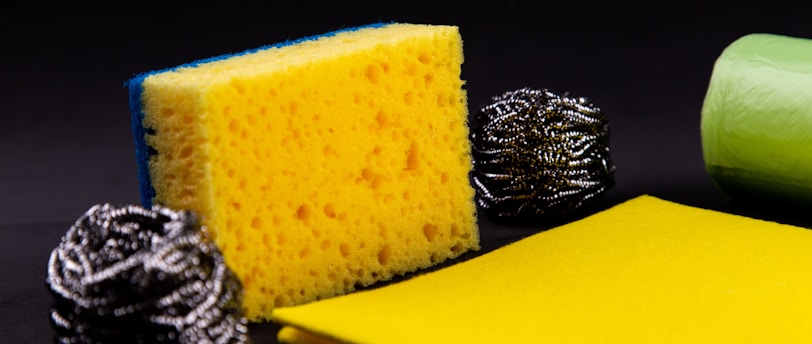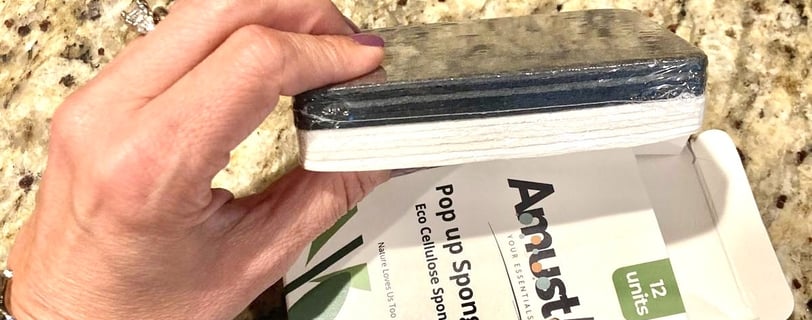Replace Your Dish Sponge at Least Once a Month and Keep Your Family Safe
Compressed Cellulose Sponges vs. Regular Sponges
Pros, Cons, and Which One to Choose
Naturesponge


When it comes to household cleaning, not all sponges are created equal. Compressed eco-friendly sponges and regular synthetic sponges each have their strengths and drawbacks, which can make choosing between them challenging. Here, we’ll break down the key differences, pros, and cons to help you make the best decision for your cleaning needs.
What Are Compressed Sponges?
Compressed sponges are made from natural cellulose, which is derived from wood pulp, making them eco-friendly and biodegradable. These sponges come in a thin, compact form and expand significantly when wet, providing a soft and absorbent cleaning tool. Their natural material ensures they’re free from synthetic chemicals, offering a sustainable option for cleaning around the house. Unlike regular sponges, compressed sponges are durable, resistant to odors, and can be safely used on a variety of surfaces without scratching.
Pros and Cons of Compressed Sponges
• Pros:
• Eco-Friendly: Since they’re biodegradable, compressed sponges help reduce waste, making them ideal for eco-conscious households.
• Durable: Compressed sponges are long-lasting, even with frequent use, which reduces the need for constant replacements.
• Scratch-Free: They’re gentle on surfaces, so they’re safe for everything from glass to non-stick cookware, making them versatile for cleaning tasks across the home.
• Highly Absorbent: These sponges are excellent for soaking up spills or cleaning surfaces effectively with minimal water and detergent.
• Cons:
• Requires Initial Wetting: Unlike regular sponges, compressed sponges need to be soaked in water to expand before use.
• Higher Initial Cost: They tend to be a bit more expensive upfront, but their durability often balances this out over time. (Buy it here a super good price)
What Are Regular Synthetic Sponges?
Regular synthetic sponges are typically made from materials like polyurethane or polyester, which are cheaper to produce but not biodegradable. They come in a pre-expanded form, which means they’re ready for use immediately. While these sponges are widely available and affordable, they can break down quickly, trapping dirt and bacteria, and often need frequent replacement.
Pros and Cons of Regular Sponges
• Pros:
• Affordability: Regular synthetic sponges are budget-friendly, making them easy to replace as needed.
• Availability: They’re widely available in most stores and come in various colors and shapes, which some users find appealing.
• Ready-to-Use: No need to soak before use; they’re always ready for quick cleaning jobs.
• Cons:
• Non-Eco-Friendly: Synthetic sponges are made from plastic-based materials that are not biodegradable, contributing to environmental waste.
• Bacteria Growth: These sponges can harbor bacteria quickly, especially when kept in damp areas like the kitchen or bathroom.
• Less Durable: Synthetic sponges often tear or fall apart with frequent use, requiring regular replacements and increasing waste.
Which One Should You Choose?
If sustainability, durability, and versatility are top priorities, compressed sponges are the clear choice. They’re more environmentally friendly, last longer, and are gentler on a variety of surfaces, making them ideal for kitchens, bathrooms, and general house cleaning. For those looking for a short-term, budget-friendly option, regular synthetic sponges may suit quick, low-impact cleaning tasks but will need frequent replacement.
While both compressed and regular sponges have their advantages, compressed eco-friendly sponges offer a long-lasting, versatile, and sustainable cleaning option for the modern household. Ideal for eco-conscious users, these sponges provide excellent cleaning power without compromising on safety or environmental impact. Make the switch to compressed sponges for a cleaner, greener, and more cost-effective approach to home cleaning!



